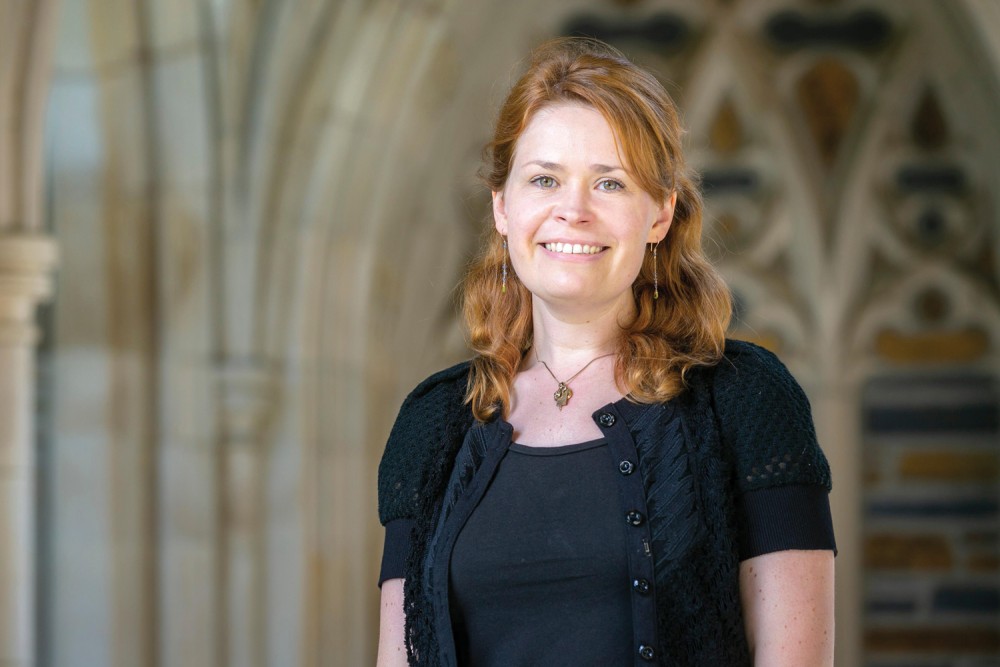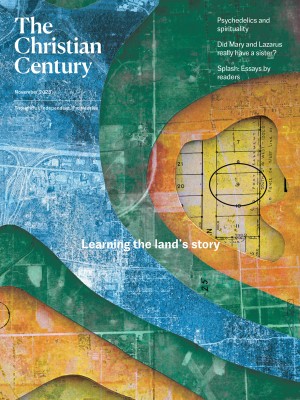Signs of Mary Magdalene in John 11
“If John’s christological confessor is also the first person the risen Jesus appears to,” says biblical scholar Elizabeth Schrader Polczer, “that could make her a competitor to Peter’s authority.”

New Testament scholar Elizabeth Schrader Polczer (Photo by Megan Mendenhall)
Elizabeth Schrader Polczer is assistant professor of New Testament at Villanova University. Her research focuses on textual criticism, Mary Magdalene, and the Gospel of John. Hear the full version of this interview on the Century podcast In Search Of.
Your path into biblical studies is a strange one, and it goes directly through Mary Magdalene. How did you become interested in Mary?
Maybe ten years into working in the music business, I wrote a song about Mary Magdalene, which was not the typical song that I write. It came to me after I prayed in a garden dedicated to the Virgin Mary. I actually heard words in response to my prayer, which were, Maybe you should talk to Mary Magdalene about that. Totally unexpected.
Read our latest issue or browse back issues.
I walked over to the Brooklyn Public Library and checked out The Complete Idiot’s Guide to Mary Magdalene. I found out that she was a controversial character. After reading about her, I decided I would really like to look at the world’s oldest copy of the Gospel of John and just see if anything there has been changed. I thought maybe the scholars missed something, which I now realize was a totally presumptuous thought.
Where did that curiosity come from?
To me it seemed like the most natural thing: Mary Magdalene was controversial. The Gospel of John is the one where she’s the most important. I wondered about that early manuscript. I feel like I’m not the first person to wonder that.
So I found out that Papyrus 66, which was copied around the year 200, is the oldest substantial copy of the Gospel of John. I looked at a transcription of it on iohannes.com, and my first thought was, Hasn’t anybody translated this? I didn’t know Greek. So I went to biblehub.com, and I was able to get an interlinear study Bible where you can see every word of the gospel and it’s translated for you. With one browser window open to Bible Hub and another one to iohannes.com, I was able to compare them.
I started with John 19 and John 20, and I didn’t see anything remarkable. Then I thought I should look at John 11. The Complete Idiot’s Guide notes that some people have always wondered whether Mary of Bethany is Mary Magdalene. So I looked at John 11, and that’s when I saw all these markings on the document.
At the beginning of the chapter, I saw that the name Mary had been crossed out two times. I couldn’t read Greek, but I knew enough to see that the name Maria had been changed to Martha in the first instance. In Greek, that’s just the difference of one letter. Then a couple of verses later, you could see that a woman’s name, probably Maria, was scratched out and changed to αἱ ἀδελφαί, which means “the sisters,” and all the verbs had been changed from singular to plural.
For four or five verses there are all these changes being made around Mary and Martha. I thought, this looks like they’re adding Martha to the story.
There’s another story with Mary and Martha in Luke 10. Papyrus 66 was copied in the year 200, so the copyist probably knew Luke’s Gospel. Is the copyist adding the character Martha from Luke, sticking her into John? That’s what it looked like to someone who had no training.
People have always wondered if the Mary in John 11 is Mary Magdalene, but I’d never read anything about these markings. I knew I hadn’t discovered something that nobody had seen before. It’s just that nobody seemed to care. But I was just so certain that this mattered. I found some articles written by scholars like Gordon Fee, one of the best textual critics of the 20th century. He observed that the name Mary was changed to Martha, and he noted the place where it was changed to αἱ ἀδελφαί. He wrote that in 1965, and that was the end of it.
Eventually, I enrolled in a master’s program at General Theological Seminary to explore this further. My thesis was a study of 150 transcriptions of John 11. It turns out that there are problems with Mary and Martha all over the place. Sometimes you see Mary’s name changed to Martha’s; sometimes you see Martha’s name awkwardly added in the margin. Sometimes you see Mary doing things that your Bible would say that Martha does.
Why does it matter that this potentially Mary Magdalene figure in John 11 has been split in two?
Right now most people reflexively think that Lazarus’s sister Mary is also Martha’s sister Mary. I’m theorizing that Martha was added at a later stage and that Martha was not a sister of Lazarus.
The story found in Luke 10 of Martha and Mary—where Martha is doing service and Mary is sitting at Jesus’ feet and Martha complains—is a different story by a different gospel author. So many women were named Mary at that time, it’s hard to tell which Mary is which, but when Martha is included in the Lazarus story, it makes you think that Lazarus’s sister Mary is Martha’s sister Mary. But in Luke 10, Mary and Martha don’t have a brother. Martha and Mary in Luke could be a different family than Lazarus and Mary in John’s Gospel, but when you add Martha to the story in John, it distracts the reader into thinking of Luke. This eliminates the possibility that Lazarus’s sister Mary might be Mary Magdalene.
But if you read John 11 without Martha, then you can see that John seems to be deliberately putting the idea in readers’ heads that Lazarus’s sister Mary could be Mary Magdalene. She’s named Mary, and both of them are at a tomb and crying, and both of them see someone rise from the dead. There are a lot of textual parallels that commentators have noticed between John 11 and John 20 that you’re less likely to notice if Martha’s there. So the addition of Martha distracts the reader from noticing how very similar John’s Mary from chapter 11 is to Mary Magdalene.
Here’s the reason that it really matters: right now in your Bible as it is translated, Martha, not Mary, gives the crucial christological confession. Jesus says, “I am the resurrection and the life, those who believe me will never die, do you believe this?” Martha says, “Yes Lord, I believe that you are the Christ, the Son of God, the one coming into the world.” That is considered to be the central christological confession in this gospel.
But what if Mary had said it? In fact, Tertullian, a church father who was writing around the same time Papyrus 66 was copied, thinks that Mary uttered that christological confession. This is why it really matters whether Martha’s there or not. Right now, Martha’s a minor character and people forget that she’s the one who gives the christological confession. She drops out of the narrative after this confession.
In Tertullian’s copy, Mary gives the christological confession—and anoints Jesus. She’s there at the foot of the cross standing by Jesus in his darkest hour. She goes alone to the empty tomb on Easter morning, where Jesus appears to her first. She gets the first commission of the risen Jesus in John 20 to go to the disciples and announce that he’s risen from the dead.
All of this makes her an essential character in the Gospel of John. It also makes her, perhaps, a threatening character—because the woman’s christological confession in John is quite similar to Peter’s confession in Matthew 16:16. Peter derives a lot of authority from being the first to confess that Jesus is the Christ.
If John crafted a gospel where the christological confessor is also the first person that the risen Jesus appears to, that’s a problem. That could make her a competitor to the authority that Peter ended up getting. But if you put Martha in there, the problem is solved. Now the person who confesses Jesus is the Christ is a forgettable minor character. It would make sense editorially to diminish it. It would’ve made the gospel palatable and perhaps acceptable for our canon.
That’s a stunning account. How has this research affected your understanding of truth in the Bible?
Seeking truth in biblical texts is a somewhat subjective enterprise, because everyone is bringing themself to the text and they will see different things. Humility when approaching the text is really important: knowing that you are a product of your time and you’re asking questions that are particular to your time.
On the other hand, I wouldn’t say that the question of women’s authority is particular only to our time. Look at the Gospel of Mary. That’s a second-century text that asks questions about women’s authority. So that one is a perennial question.
John’s Gospel says that the spirit of truth cannot be received (14:17). So for me, there’s actually something very theological about digging into these variants in John. I personally found that the deeper I went into myself, the deeper I was able to go in John. It almost felt like the gospel was showing a wound in the text to me, saying, “Let me show you this.” It felt like an invitation, asking, “Can you help?” Each textual variant was revealing a new aspect of the vulnerability of the word of God. That is so theological, in a very Johannine way.
It’s almost like the gospel itself is moving and meeting us where we are. At the time, the gospel met people where they were, and now there might have been a shift so that the gospel reveals itself in a new way, meeting us where we are now. That’s how I see the gospel. That’s what I would see as truth.
I kept looking at John 11, and this one verse kept popping out to me. Speaking of Lazarus, Jesus says, “This illness is not unto death, but it is for the glory of God in order to glorify the Son through it” (11:4). It’s almost like the text predicted its own illness. There’s an illness in the text, but do you really think that Jesus doesn’t know that? Do you really think that God doesn’t know what has happened? This illness is allowed to stay to show that no matter what human sinfulness might do to serve our own purposes, the truth comes out in the end, and in the end it’s for God’s glory.






